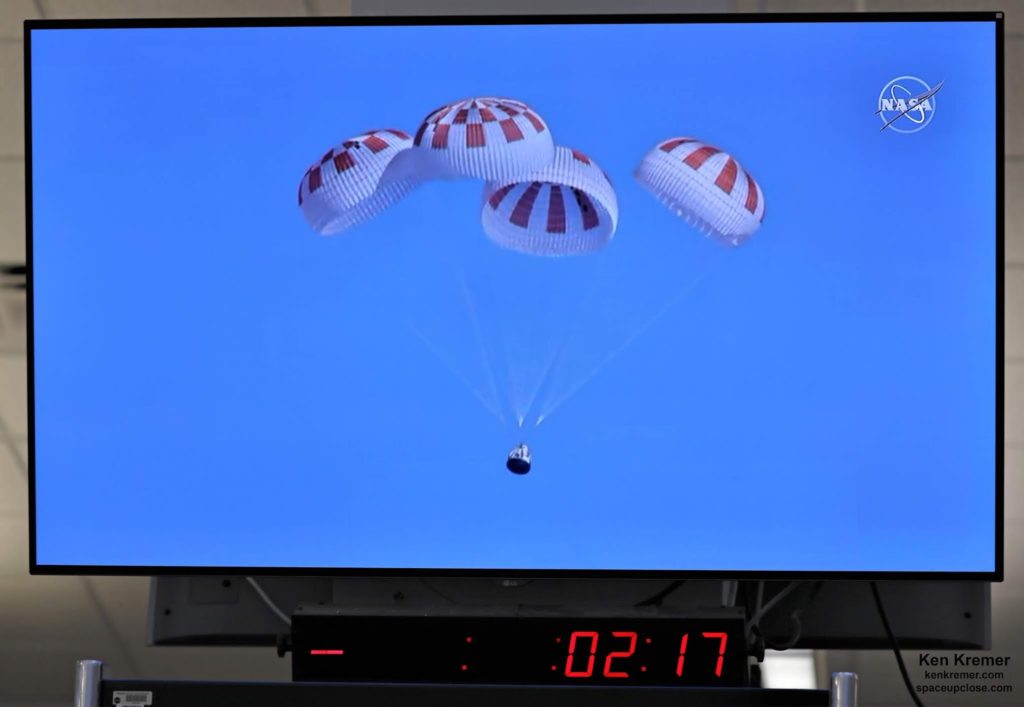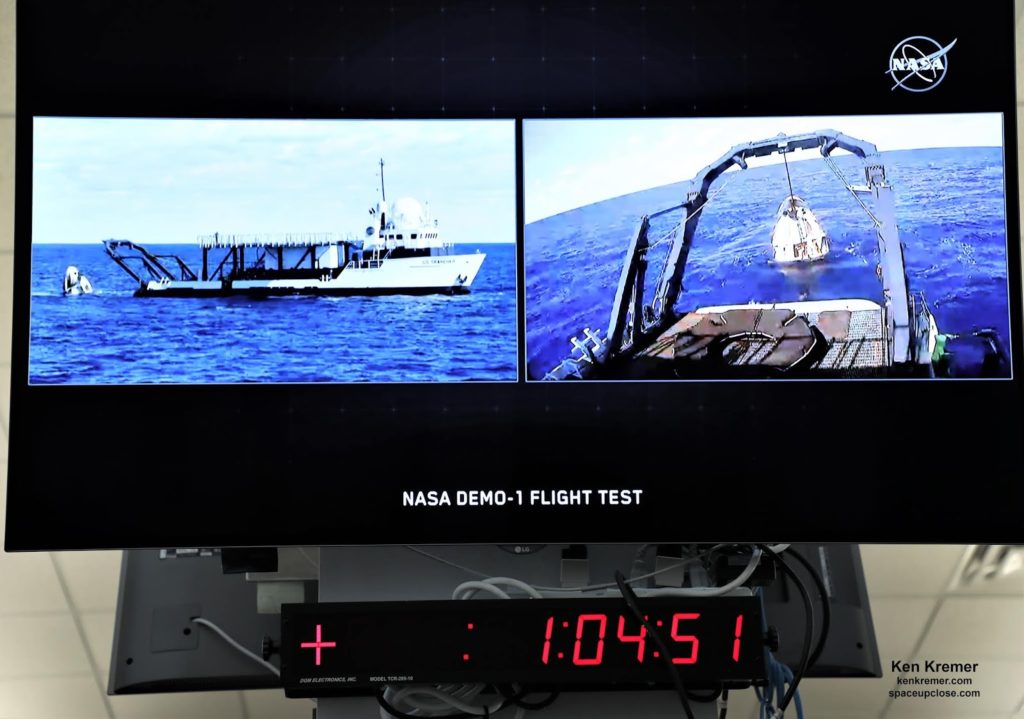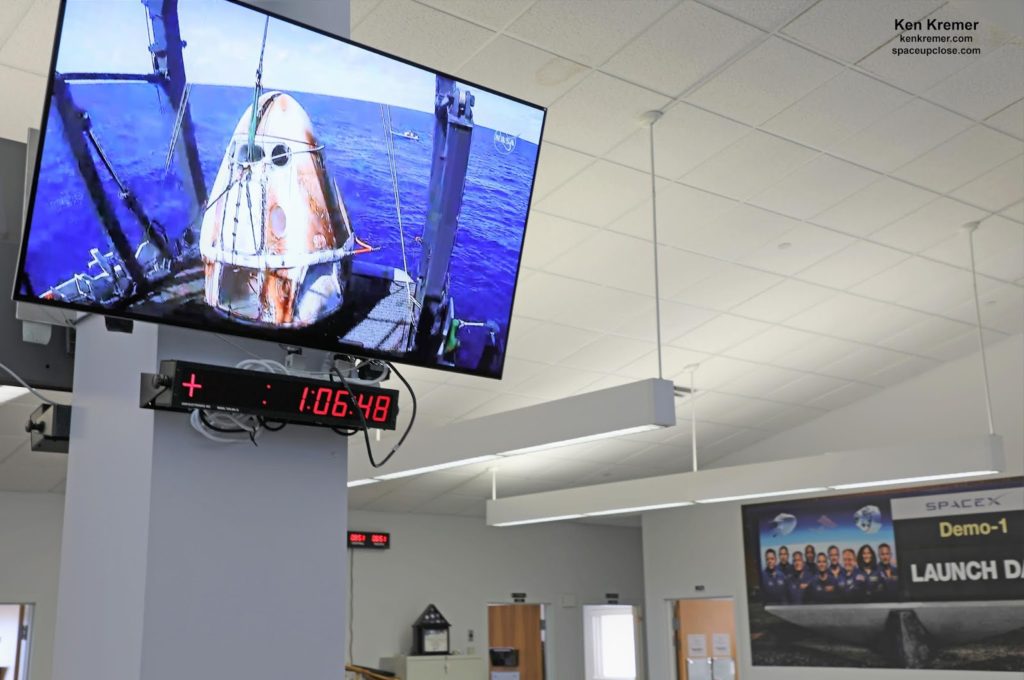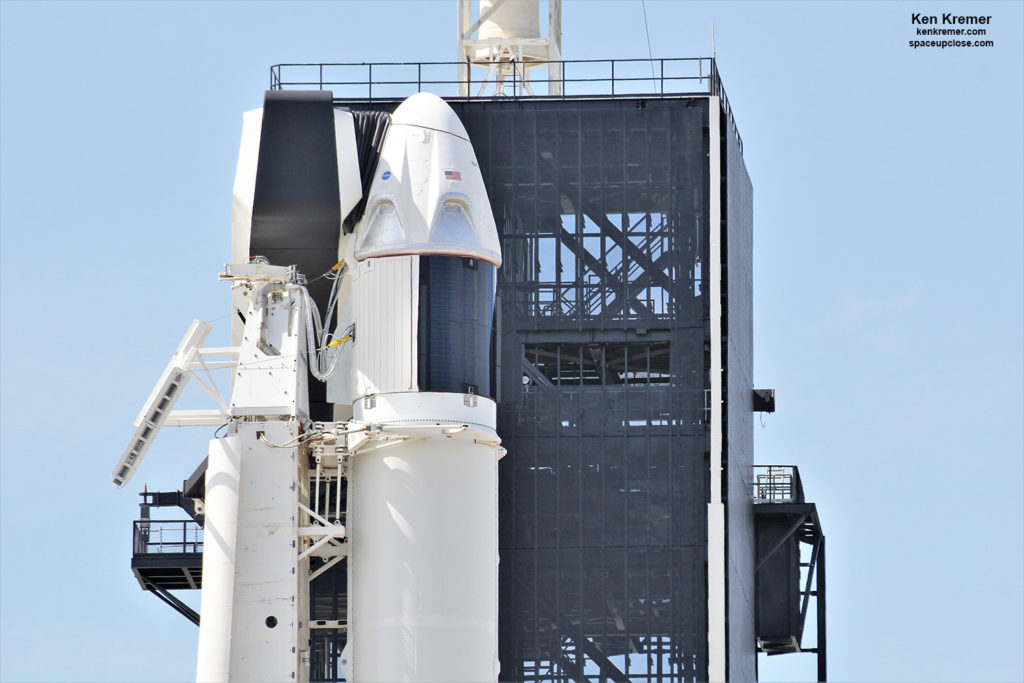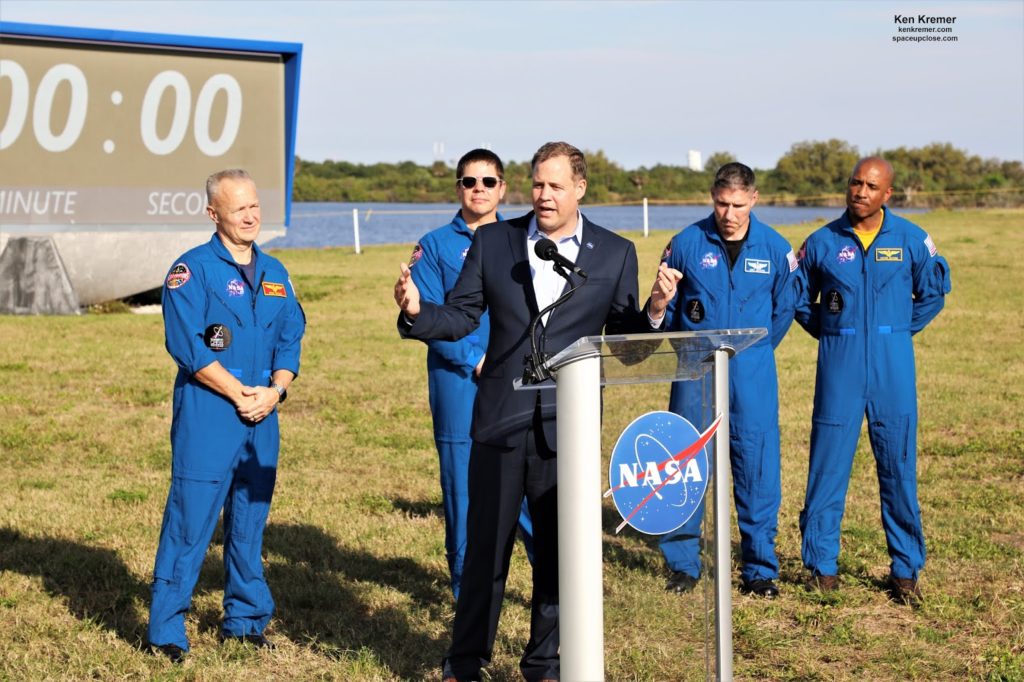Ken Kremer — SpaceUpClose.com & RocketSTEM – 8 March
2019
KENNEDY SPACE CENTER, FL – SpaceX’s commercially built Crew Dragon spacecraft concluded its historic
first unmanned test flight with a successful return to Earth and splashdown in the Atlantic
Ocean Friday morning, March 8, paving the way to a resumption of human launches
from American soil as soon as this summer – and a ‘new era’ in spaceflight spurred by public-private
partnerships and investments.
The six
day SpaceX mission of the inaugural Crew Dragon spaceship dubbed ‘Demo-1’ was ‘fully
successful’ and marks a major milestone in NASA’s overarching goal to restore
America’s capability to launch American astronauts in American capsules on
American rockets to low Earth orbit (LEO) and the International
Space Station (ISS).
A two
person crew of NASA astronauts are already selected and trained and will launch
on the first mission with humans aboard on the ‘Demo-2 mission’ sometime later
this year- in the July timeframe or later depending on the outcome of post
flight technical reviews of the Demo-1 mission.
Based on
today’s outstanding success, NASA is a significant step closer towards resumption of American human
spaceflight.
Crew Dragon splashed down at 8:45 a.m. EST (1345 GMT)
Friday in the Atlantic Ocean approximately
230 miles northeast of the coast of Cape Canaveral, Florida – some six hours
after undocking from the forward port of the ISS Harmony module at 2:31 a.m.
EST (0731 GMT).
The splashdown took place as planned on time and
on target as the SpaceX recovery fleet watched and waited nearby within a few miles, under exceptionally
good weather conditions and calm sea states – as shown live on NASA TV.
Four giant orange and white parachutes unfurled
to slow the Dragons descent and complete the first end-to-end
uncrewed test flight. One of the parachutes unexpectedly covered the
capsule and had to be pulled off by the recovery team.
“It was a picture perfect conclusion to a picture
perfect mission,” said Steve Stich, deputy manager of NASA’s commercial crew program.
The SpaceX GO Searcher recovery vessel soon closed
in and the team hoisted the Dragon capsule from the ocean waters by the side
hatch using a deck mounted hydraulic lifting crane approximately 65 minutes
after splashdown.
Looking a lot like a toasted marshmallow, it was placed on a restraining
cradle on rails that can be moved back and forth below the heliport that sits
atop Go Searcher.
Orange colored scorch marks from the blazing
heats of reentry at 17,000 mph were visible from top to bottom on portions of
the capsule.
NASA’s requirement is to have the Dragon onboard
within 1 hours and for the crew to be transported to a nearby airport within 3
hours.
Under normal circumstances the crew would remain
onboard Go Searcher – unless there is a medical need to evacuate earlier.
GO Searcher is now under way transporting Dragon
back to home base in Port Canaveral, Florida. It is expected to arrive about 30
hours after ocean retrieval- thus sometime Saturday afternoon.
“This was a really successful mission. Fully
successful in accomplishing all objectives,” Stich elaborated.
“This counts as the first successful test flight
of NASA’s commercial crew program.”
“Today’s successful re-entry and recovery of the
Crew Dragon capsule after its first mission to the International Space Station
marked another important milestone in the future of human spaceflight,” said
NASA Administrator Jim Bridenstine, in a post splashdown appearance on NASA TV.
“I want to once again congratulate the NASA and
SpaceX teams on an incredible week. Our Commercial Crew Program is one step
closer to launching American astronauts on American rockets from American soil.
I am proud of the great work that has been done to get us to this point.”
The
SpaceX Crew Dragon and Boeing Starliner CST-100 human spacecraft are currently development under
NASA’s $6.8 Billion Commercial Crew Program (CCP) -with the goal to once
again ferry American astronauts to the International Space Station (ISS) from American
soil on American rockets to end our sole reliance on the Russian Soyuz crew
capsule for the first time since the forced shutdown of NASA’s space shuttles in
2011.
SpaceX
was awarded a $2.6 Billion contract while Boeing received $4.2 Billion. Boeing
hopes to fly its maiden unmanned Starliner mission later this spring atop a ULA
Atlas V rocket followed by a manned mission later in the year.
Loaded on board was Ripley, seated inside Dragon
as a simulated astronaut as what NASA dubs “an anthropomorphic test device”
named after the protagonist in the movie ‘Alien.”
Ripley became an instant internet sensation
and is outfitted with sensors to provide data about potential effects on future
astronauts who will travel in the Crew Dragon.
The cargo included more than “400 pounds of
crew supplies and equipment to the space station, including bulk overwrap bags
containing more than 1,000 food and drink packages for the crew.”
sample packages and crew clothing.
Also aboard was an Earth plush toy that instantly
became famous and a world-wide sensation when shown off by Expedition 58 crew member
and NASA astronaut Anne McClain – and became known as as ‘Little Earth.’
For
the return trip to Earth, the Expedition 58 crew loaded Dragon with about 300
pounds of cargo including 2 cold stowage bags packed with important science
research samples.
The Expedition 58 trio crew currently aboard station comprises NASA
astronaut Anne McClain, David Saint-Jacques of the Canadian Space
Agency, and Russian cosmonaut and Expedition 58 commander Oleg
Kononenko.
The physical separation of Crew Dragon from the
ISS took place 250 miles over Sudan, Africa this morning at 2:31 a.m. as 2 hook
sets were unlatched. The Dragon was also commanded to fire thrusters to initiate
the separation with two quick separation burns of 1.5 seconds each in duration.
Two more burns were commanded later.
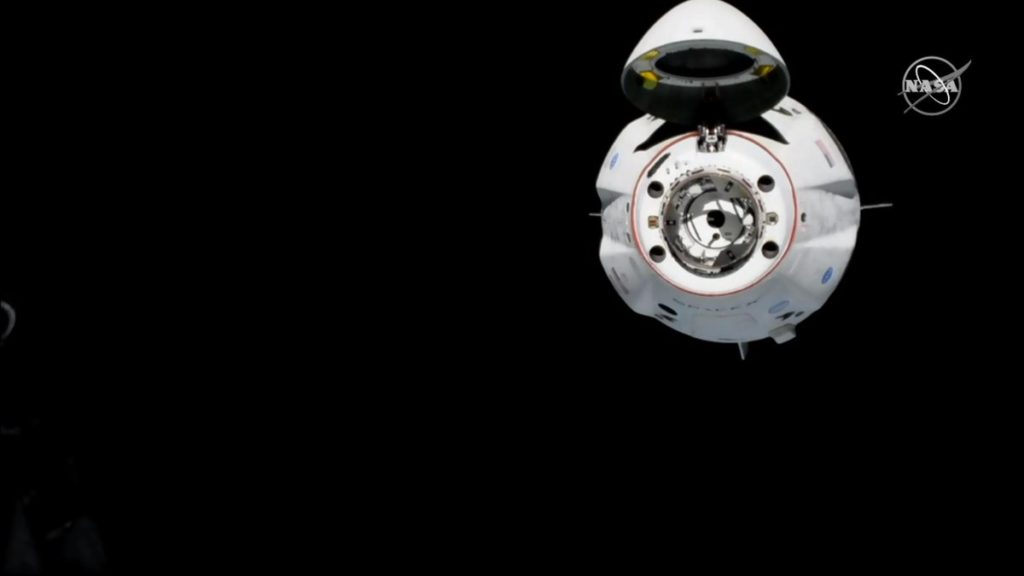 |
|
SpaceX Crew Dragon undocks and pulls away from ISS on March
8, 2019 with nose cone open prior to re-entry and splashdown. Credit: NASA TV |
The deorbit burn followed later starting at 7:53
a.m., with planned 15-minute 25-second burn of
Crew Dragon’s Draco thrusters that slowed the ship to enter the Earth’s
atmosphere.
SpaceX’s Crew Dragon lifted off on this maiden
test flight dubbed Demo-1 atop a SpaceX Falcon 9 rocket at 2:49 a.m. EST (0749 GMT) Saturday, March 2 from historic Launch Complex-39A at NASA’s
Kennedy Space Center in Florida.
Crew Dragon is the first commercially built
American spacecraft designed to carry humans to the orbiting laboratory that
has actually docked.
“If you just think about the enormity of this
flight and all of the prep that went into it – getting the pad refurbished,
getting the flight control room set up, getting the vehicle built, getting the
Falcon 9 ready, all of the analysis and mission support that went into it –
it’s just been a tremendous job. Our NASA and SpaceX teams worked seamlessly not
only in the lead-up to the flight but in how we managed the flight,” said Steve
Stich, deputy manager of NASA’s Commercial Crew Program.
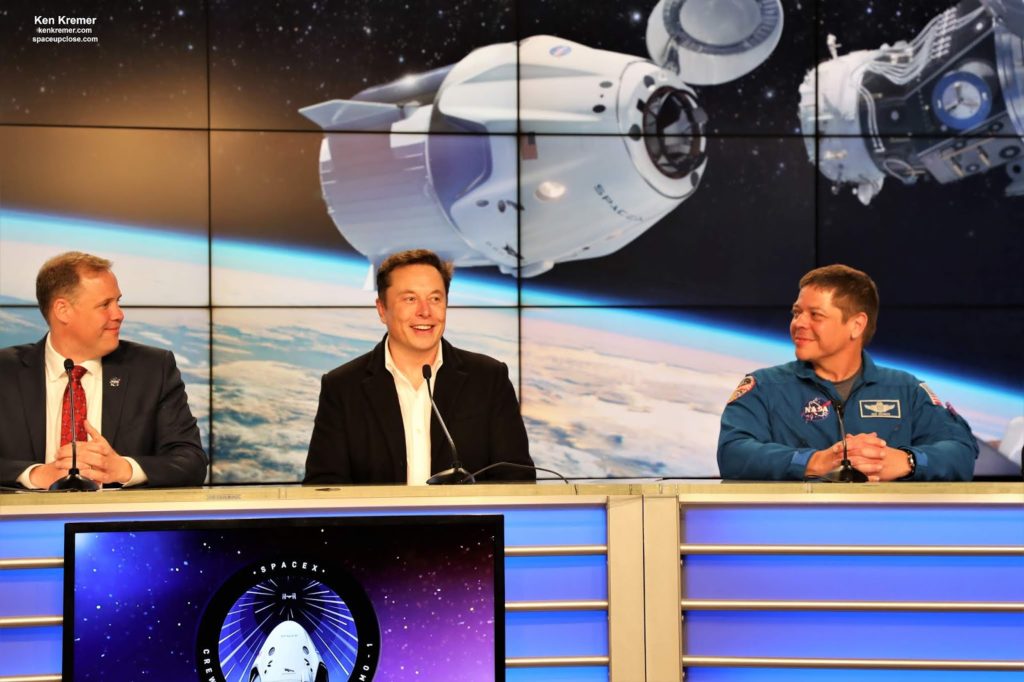 |
|
Elated Elon Musk, SpaceX CEO after successful Demo-1 launch 2:49 AM on Falcon
9 rocket historic from Launch Complex 39A – flanked by elated NASA Administrator Jim Bridenstine and NASA Demo-2 mission Astronaut Bob Behnken at post launch briefing at NASA’s Kennedy Space Center Press Site. Credit: Ken Kremer/kenkremer.com/spaceupclose.com |
Here is a list of firsts from NASA:
·
First commercially-built
and operated American crew spacecraft and rocket to launch from American soil
on a mission to the space station.
First commercially-built
and operated American crew spacecraft to dock with the space station.
First autonomous docking
of a U.S. spacecraft to the International Space Station.
First use of a new,
global design standard for the adapters
that connect the space station and Crew Dragon, and also will be used for the
Orion spacecraft for NASA’s future mission to the Moon.
The Demo-1 Crew Dragon successfully attached
to the forward facing port on the International
Space Station’s Harmony module for a “soft capture” Sunday, March 3,
at 5:51 a.m. EST while the station was traveling more than 250 miles over the
Pacific Ocean, just north of New Zealand.
The gumdrop shaped vessel operated in a fully autonomous
mode after completing 18 orbits of Earth since launching in the middle of the
night Saturday morning.
stage on the OCISLY droneship 9 minutes after liftoff.
It was towed into Port Canaveral 3 days later
on March 5. My story and photos here at Space UpClose.
 |
|
Dr. Ken Kremer of Space UpClose interviewed live on BBC Breakfast
TV News about the successful SpaceX Crew Dragon launch and implications for future spaceflight. Credit: BBC/Space UpClose |
 |
|
Dr. Ken Kremer of Space UpClose interviewed live on BBC
World News about the successful SpaceX Crew Dragon launch and implications for future spaceflight. Credit: BBC/Space UpClose |
Watch for Ken’s ongoing
onsite mission coverage of SpaceX Demo-1 mission at the Kennedy Space Center.
NASA, SpaceX, ULA, Boeing, Lockheed Martin, Northrop Grumman and more space and
mission reports direct from the Kennedy Space Center, Cape Canaveral Air Force
Station, Florida and Wallops Flight Facility, Virginia.
tuned here for Ken’s continuing Earth and Planetary science and human
spaceflight news: www.kenkremer.com –www.spaceupclose.com – twitter @ken_kremer –
email: ken at kenkremer.com
and journalist based in the KSC area, active in outreach and interviewed regularly
on TV and radio about space topics.
Ken’s photos are for sale and he is available for lectures and outreach events
more about the upcoming/recent ULA
Delta 4 WGS-10, SpaceX Demo-1, Falcon 9 Nusantara
Satu launch, USAF GPS 3-01, SpaceX Falcon 9/CRS-16 launch
to ISS, NASA missions, ULA Atlas &
Delta launches, SpySats and more at Ken’s upcoming outreach events at Quality Inn Kennedy Space Center, Titusville,
FL, evenings:
Delta 4 WGS-10 launch, SpaceX Falcon 9 Demo-1 and Nusantara Satu launch, Dragon
CRS-16 resupply launch to ISS, SpaceX Falcon GPS 3-01, SpaceX Falcon Heavy
& Falcon 9 launches, upcoming SpaceX Falcon 9 USAF GP3 3-01, NRO & USAF
Spysats, SLS, Orion, Boeing and SpaceX Commercial crew capsules, OSIRIS-Rex,
Juno at Jupiter, InSight Mars lander, Curiosity and Opportunity explore Mars,
NH at Pluto, Kuiper Belt and more,” Kennedy Space Center Quality Inn,
Titusville, FL, evenings. Photos for
sale
upcoming talks:
& A Journey in 3-D.” 7 PM, Lawton C Johnson Middle School, Summit, NJ. Open to
the public. Details upcoming. Latest results from Mars & Ultima Thule




